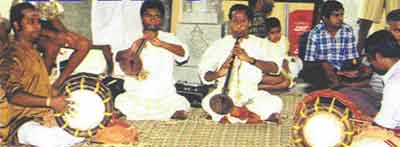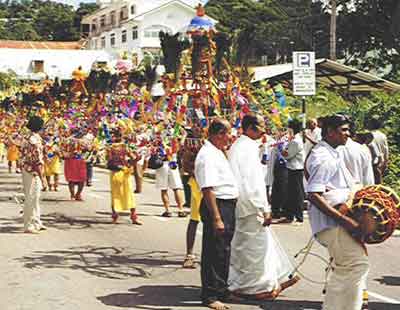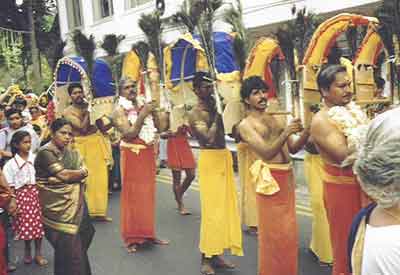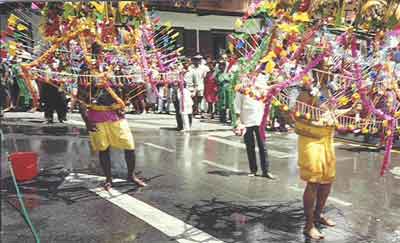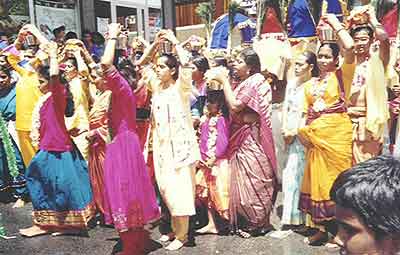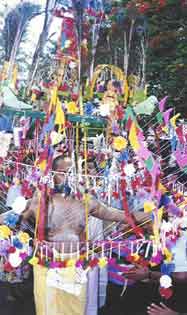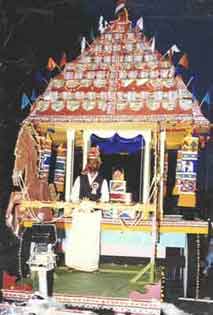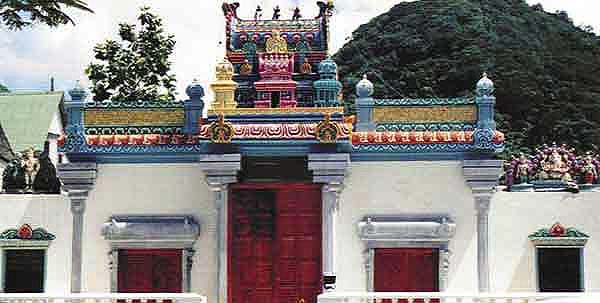
|
||||||||||||||||
|
| ||||||||||||||||
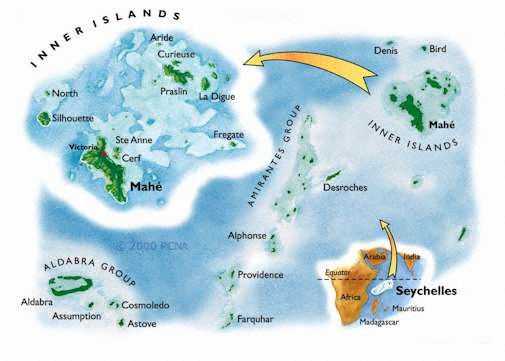
Taippoosam Kavadi Festival in Seychellesby Vijaratnam ŚivasupramaniamSeychelles is an archipelago of 115 islands located between four and five degrees south of the equator on the western part of the Indian Ocean. It is a paradise of islands floating like tiny gems in the clear waters of the Indian Ocean. It is a little over one thousand miles from India and Sri Lanka in the northeast, from the eastern coast of Africa in the west and from Mauritius in the south. The population is just over 80,000, 90% of whom live on the mainland of Mahe with Victoria as its capital. The rest of the population is spread over in about thirty inhabitable islands. Although recorded history has it that the Portuguese first sighted these islands and French settlers landed in 1770, there is ample evidence to show that Asians such as Arabs, Chinese and Tamils visited these islands during the 15th and 16th centuries.
The first Tamil, Ramalingam from Reunion, came to Seychelles in 1789 as an advisor to the Governor and was endowed with large areas of land for his services. In 1864 the Naiken family established their business followed in 1874 by Kandasamy Chetty in business. Now one may see Tamil influence here in the frequency of common Tamil names such as Pillai, Chetty, Govindan, Naiken, Kandasamy and Vadivelu and a large number of them are in the business community. For 222 years Tamils have had a continuous and uninterrupted history in this island. For 300 or more years they have had a history in this region comprising of Seychelles, Mauritius, Reunion and South Africa. Even though fellow Tamils in other settlements in this region established centres of cultural and religious significance for themselves, Seychellois Tamils did not establish any such centre. Their cultural thirst and religious needs were satisfied through periodical visits to their native Tamilnadu. Attempts were made to hold cultural festivals when Tamils assembled and celebrated their days of cultural importance. However, the absence of an established centre made these efforts intermittent. For well over 200 years the Tamil settlers became integrated with the local population resulting in inter-marriages and some conversions also. They became well versed in the local creole language also. Now Tamils own a large number of business houses. In the course of this development their traditional values including language, religion and culture took a back seat in the land of their settlement. The inter-mingling of races -- British, French, African and Asian -- and mixed marriages without barrier of colour created a multi-faceted and almost unparalleled community, a peaceful community that is a good example for other countries. Another important feature is the acceptance of three languages – English, French and Creole – as the official languages of the country. In 1901 there were 332 Tamil-Hindu families out of a population of 19,237 and now there are about 3500 Tamil speaking people. Taippoosam, a Hindu religious day dedicated to Lord Murugan whose abode is usually the hills and mountains, is celebrated annually on a large scale in South India, Sri Lanka, Malaysia, Singapore, Mauritius, Reunion, South Africa and in all other places where there are temples for Lord Murugan. Lord Murugan, the warrior god with a vel (spear) in his hand, is regarded as the destroyer of evil and the preserver of the good. The Hindu population of Seychelles numbering a few thousands, although yearning to have a common place of worship to call their own, could not organise themselves to translate their desires into a reality. There were a few abortive attempts. Hindus sought private premises to give vent to their spiritual feelings and aspirations. It was only in 1984 that an expatriate enthused a few Hindus who intuitively thought that the time had come to establish a religio-cultural centre for Hindus. The group worked with missionary zeal and convinced conflicting opinion-holders into streamlining their thoughts and deeds towards building up a coherent association, which became the Seychelles Hindu Kovil Sangam. The main purpose of the S.H.K.S was to build a temple to cater to the spiritual and cultural needs of the Hindu population. The dormant energies of all the Hindus sprouted spontaneously through the newly formed organization to buy land in the heart of Victoria and build a full-fledged Hindu temple in traditional architecture within a short span of eight years by May 1992. It was nothing but providential that the Arulmigu Navasakti Vinayagar temple stands as a living monument of what united effort could achieve. It is a worthy gift for generations to come in this beautiful island. The organization of the Seychelles Hindu Kovil Sangam in 1984 and the consecration of the Navasakti Vinayagar Temple in May 1992 were landmarks for the resurgence of Tamil cultural activities apart from the religious awakening. The Kovil Sangam became the rallying base for all the Tamils and Hindus for the promotion of Tamil culture in this country. Active participation in Tamil classes, debates, dramas and other cultural events including Tamil publications has increased over the years. This temple combines a cultural institution with a holy home for religious needs. It fills a void, rectifying a long-standing defect, by facilitating an emotional need to help in nation building. The temple provides a religious base and the presence of the priests encouraged a religious awakening such that religious rites and ceremonies have been on the increase in many Hindu homes in Seychelles. The Arulmigu Navasakti Vinayagar Temple, the first and the only Hindu temple in Seychelles, has Lord Ganesha as the presiding deity. Since 1999 Lord Ganesha is taken out along the outer courtyard on Vinayagar Chathurti day amid great pomp and pageantry. Apart from the presiding deity, icons of Lord Murugan, Lord Nadarajah, Goddess Durga, Sreenivasa Perumal, Bhairawa and Chandekeswarar are enshrined in the inner mandapam of the temple. Appropriate prayers, pujas and festivals are performed for the different deities on special occasions. Taippoosam Kavadi Festival, which started in 1993 in Seychelles in the inner courtyard of the temple, is now conducted in the outer courtyard and a chariot kavadi is also taken out in procession. This festival has gained popularity as a national festival, so much so, that as from 1998 the Government has declared it to be a holiday for Hindus. The annual Taippoosam Kavadi Festival since
Tradition has it that Lord Murugan married Valli, one of his two consorts, on this Taippoosam day and therefore it is considered a special day for celebrations. Hindu deities have animals and birds as their vehicle and peacock is the vehicle for Lord Murugan. Hence the metal frame of which the kavadi is made is fully decorated with peacock feathers that are blue in colour – philosophically blue is the colour of the sky and the ocean – suggesting the colour of the universe. Kavadi, the central wooden beam represents the human body while the two pots hanging on either side represent the good deeds done in one's true life on one side and the evil on the other side. Carrying this on his shoulders, the devotee appeals to the Lord for forgiveness for his evil deeds and blessings for the good deeds. Certain devotees in order to show their willingness to offer themselves in the name and service of God in the form of penance and austerity, carry the symbol of Lord Murugan with Vel-shaped pins pierced all over their body to show their tolerance to suffering inflicted in the name of God. In turn this prayer is symbolic of the willingness of the person to suffer for others out of humility and humbleness towards the Lord and one's fellow human beings. Silver or steel vel in many sizes are pierced into through skin, back, cheeks and tongue of the kavadi-carrying devotees, signifying that the vel destroys all the desires and evils in man and purifies him to be a noble soul. The carrying of the kavadi with all these rituals is a process of purifying the soul. The piercing by these sharp pins and skewers is an art by itself done only by expert hands. The will power, concentration and piety of the devotee are such that no pain is evident and it is strange that not a single drop of blood may be seen. An experienced hand could only perform this exercise of piercing and a specialist in this field is always brought from India to do this job. The music troupe brought from Tamilnadu, consisting of nadaswaram and tavil, forms an important part of the procession. No Hindu function, religious or social, is complete without this musical troupe. They not only provide appropriate music for the kavadi procession but also contribute in no small measure for the easy piercing of the skewers and pins into the body. The musical notes and the vibrations produced also have a soothing effect thus avoiding pain. Murugan represents the bliss and beauty of nature. He is the aesthetic symbol of Tamil culture linked to dance and song. Kavadi songs and dances along with the uproar of "Vel! Vel!" in chorus from the devotees underlines Tamil identity and the Kavadi Festival procession provides cultural feast for the eyes of Seychelles residents of all communities. The first Kavadi Festival in Seychelles in 1993, a year after the consecration of the temple, had six pal kavadi carrying male devotees and ten pal kudam carrying female devotees with the event held inside the inner courtyard of the temple away from public view. In contrast, in 1999 there were twenty-one pal kudam carrying females, nineteen pal kavadi carrying males, ten alagu kavadis and the innovative chariot kavadi leading the procession along the public highway to the accompaniment of tavil and nadaswaram players specially flown from India for the occasion. Crowds always enthusiastically watch this with awe and admiration. Kavadi can be in many forms such as dancing kavadi, musical kavadi, alagu kavadi or flying kavadi, but the innovative one in Seychelles is the chariot kavadi in which a miniature of the chariot that is used for deities is pulled by a devotee who at the same time carries the alagu kavadi with silver skewers pierced all over his body. It is the strong will, determination and absolute piety preceded by many days of fasting and pure vegetarian diet that helps one to endure this difficult vow. As a matter of tradition, the kavadi festival concludes with annadanam, a common lunch for all. The common lunch that winds up the proceedings has a laudable philosophy behind it. It is the noble principle of care and share that is in practice. For through annadanam, everybody irrespective of their status in society is cared for equally and whatever is available is shared by all. All sit down together for the common meal. This high philosophy is common to all religions and, if practised in the true spirit, the world would become a happy place to live peacefully for all. The Seychelles Hindu Kovil Sangam over this short span of seventeen years has successfully established and entrenched some strong foundations for the preservation, consolidation and further flowering of Hindu-Tamil culture in this paradise island of Seychelles. The ever-popular kavadi festival and special Hindu festivals are covered in Tamil and English in the national media and wide coverage of such events over national radio and television are worthy of appreciation. The Sangam may be proud of having published six souvenir booklets on the temple, two compilations of devotional hymns and four annual religious calendars, all for free distribution. For the annual consecration the national daily "The Seychelles Nation" in Tamil and English publishes a special commemorative supplement. Since June 1999 the Sangam utilizes a fortnightly radio time of fifteen minutes every Friday evening to broadcast talks and devotional songs on Hindu faith courtesy of the Government of Seychelles. Finally, for one of the national day celebrations in June the Sangam had a traditional illuminated "Car Ratham" in the float procession of thirty, which not only won great applause and appreciation but also was placed first with a handsome award. Considered together, these activities suggest that there is Tamil-Hindu cultural flowering in the multi-lingual, multi-religious paradise island of Seychelles.
Articles from the First International Conference on Skanda-Murukan |
